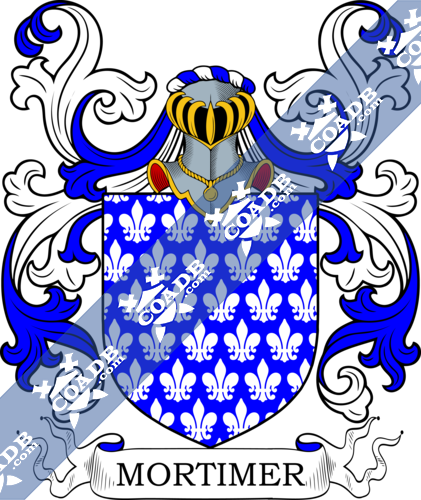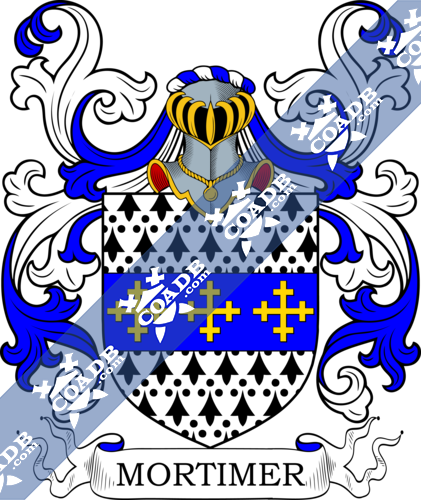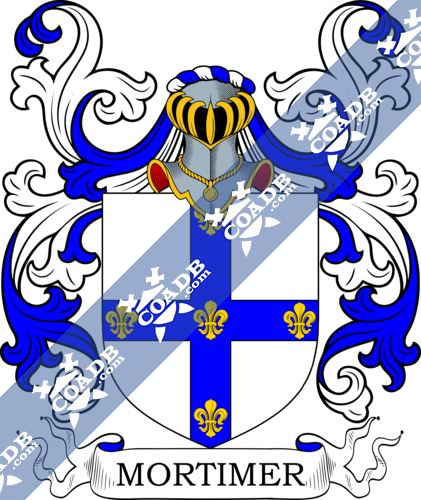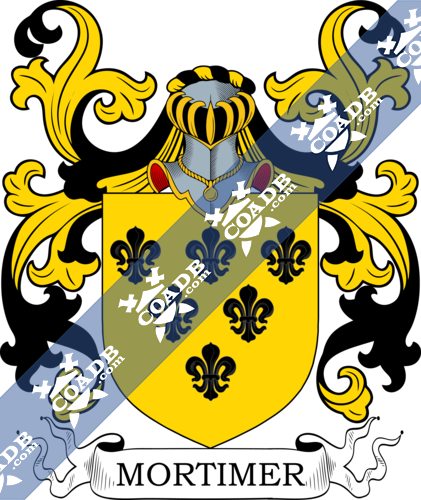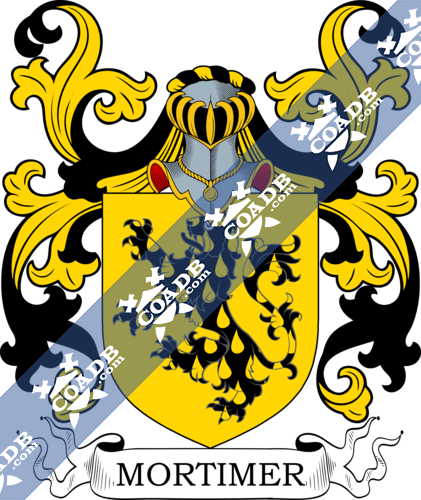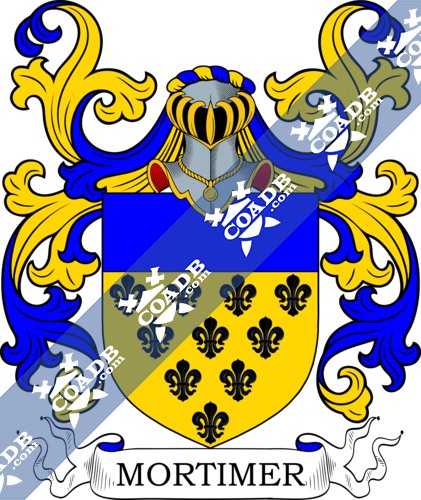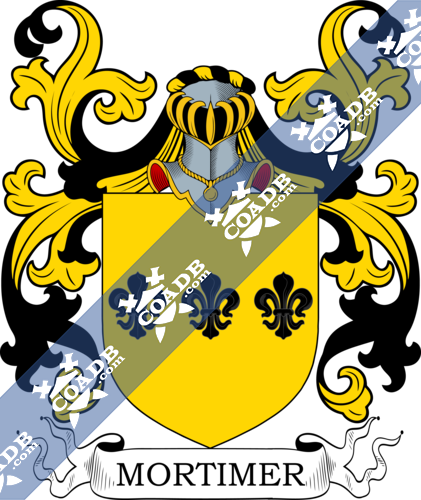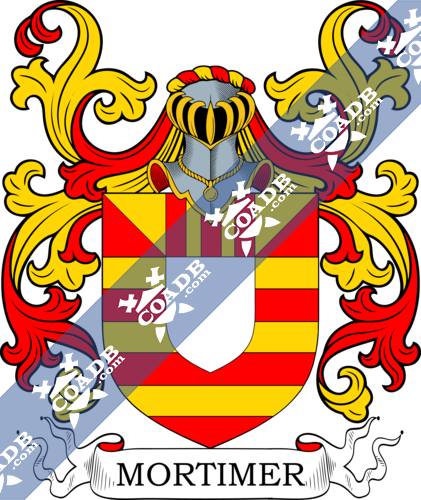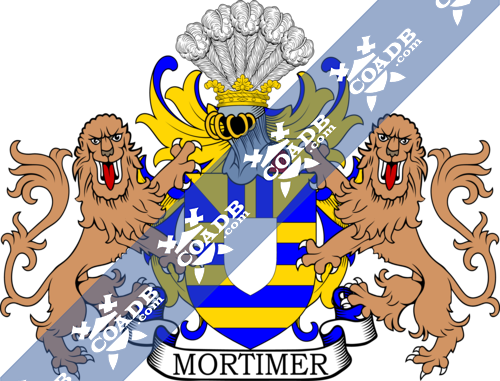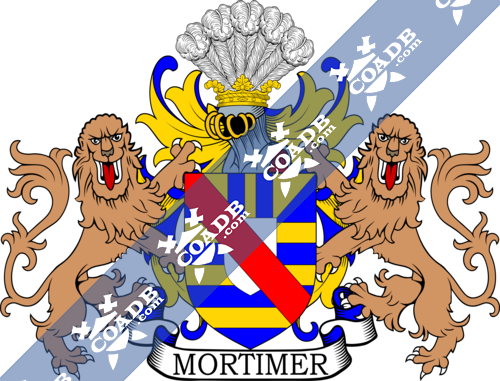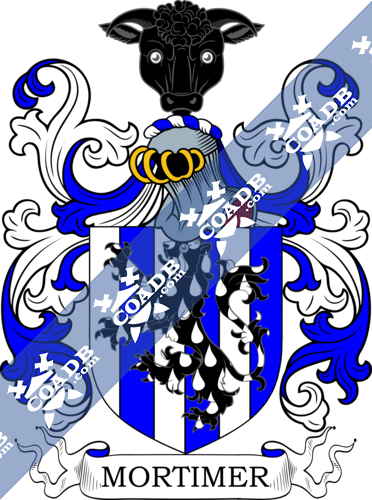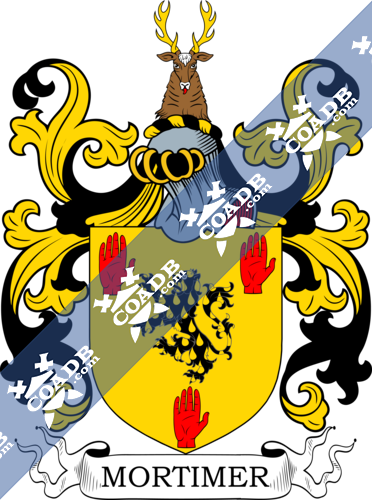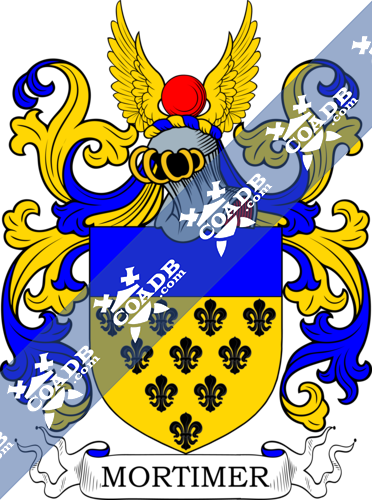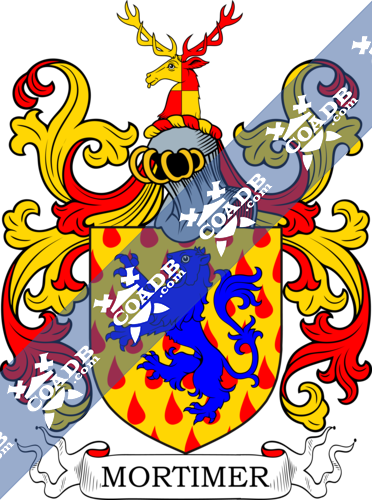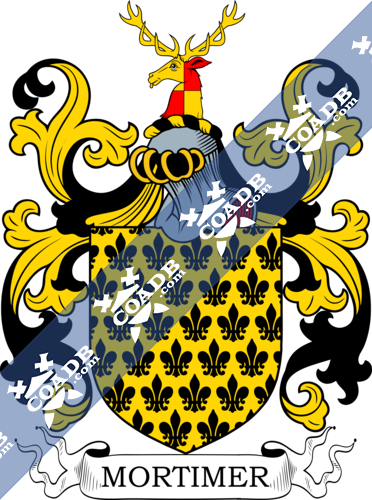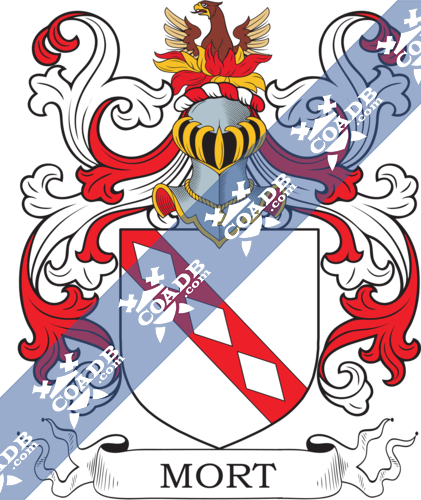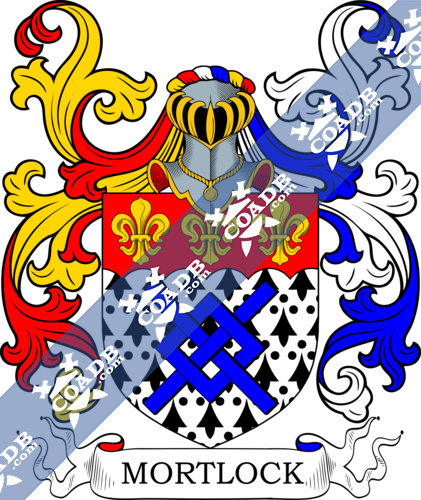Mortimer Family Crest, Coat of Arms and Name History

Mortimer Coat of Arms Gallery
Don’t know which Coat of Arms is yours?
We can do a genealogical research. Find out the exact history of your family!
Learn MoreMortimer Origin:
France
Origins of Mortimer:
According to early recordings, this name was recorded with different spellings, including Mortimer and the more uncommon Mortimore. It is one of the more famous names in history. It is English, can be Scottish and in some cases Irish, but in all terms the origin is Norman-French. It was recorded in England in the year 1066, for one Roger de Mortemer, one of the successful commanders under William the Conqueror. It was during his success that he rewarded with gifts the vast area of lands, especially in the Welsh progress. In the famous grammatical book “Patronymica Brittania” it is registered that “the palace and barony of Mortemer lie in the arrondissement of Neufchatel in Normandy”. After the year 1066, the name holders played a major part in British history, for example when Roger de Mortimer, forced King Edward II of England in 1327 to give up power in favor for his son, Edward III. Initial examples of the surname recordings, included Ralph de Mortimer of Lincoln, and Hugh de Mortuomari, both in the Hundred Rolls of the year 1273. It said that the name is an explanation of area of Normandy which was misleading and muddy, and so that mort-mer, or a deathly water.
Variations:
More common variations are: Mortimeer, Mortimere, Mortimmer, Mortimr, Mortmer, Mrtimer, Mortimeyer, Mortimor, Martimer, Mortemer.
France:
The origins of the surname Mortimer is known to be in Herefordshire where people held a family seat from early times as the King of castle and lands in that division. It is said that Ranulph de Mortimer, guided William, the successful man and was gifted Wigmore Palace in Hereford. They became the King of Wigmore. The early recordings of the spelling of the family name are shown to be that of Hugh de Mortemer, dated 1055, when he was the priest of Coutances, in France.
United States:
People with the Mortimer surname also settled in the United States in four different centuries respectively in the 17th, 18th,19th, and 20th. Margaret Mortimer and James Mortimer came to Pennsylvania in the years 1683 and 1696.
The following century saw many more people with Mortimer surnames arrive including Alexander Mortimer and Edward Mortimer came in Maryland in the years 1716 and 1726. Isabel Mortimer and Robert Mortimer settled in America respectively in the years 1758 and 1773.
People with the Mortimer surname who arrived in the 19th century included John Mortimer in the year 1809 in America. Benjamin Mortimer in New York in 1812. Charlotte Mortimer, Edmund Mortimer, and Martha Mortimer landed in New York in the year 1831.
People with the Mortimer surname also arrived in the United States in the 20th century included Alfred G. Mortimer in 1903. Allan L. Mortimer, at the age of 24 and Aileci Mortimer, aged 42 settled in America from Bradford, England in the year 1907. Alex Mortimer and Alfred James Mortimer landed in America in the year 1908.
Canada:
People of Mortimer family who settled in Canada in the 18th century included Richard Mortimer arrived in Nova Scotia in 1749.
Australia:
Some of the Mortimer family who settled ultimately in Australia in the 19th century included John Mortimer, an English prisoner from Middlesex, aboard the ship Almorah on April 1817, arrived in New South Wales, Australia. William Mortimer, Hannah Mortimer, William Mortimer Mortimer arrived in Adelaide, Australia aboard the ships ” Asia” and ” Buckinghamshire ” in the year 1839.
Here is the population distribution of the last name Mortimer: United States 6,705; England 9,991; Australia 3,134; Canada 1,380; South Africa 2,940; Scotland 833; Wales 519; Brazil 413; New Zealand 660; The Bahamas 642.
Notable People:
Mortimer J. Adler (1902–2001), was an American philosopher, professor, and writer.
Mortimer Caplin (born 1916), was an American lawman and educated man.
Mortimer Collins (1827–1876), was an English poet and novel writer.
Mortimer Davis (1866–1928), was a Canadian businessperson and contributor.
Mortimer Durand (1850-1924), was a British politician and civil attendant in British India.
Mortimer Fitzland Elliott (1839-1920), was an American lawmaker man.
Blazons & Genealogy Notes
1) (Baron Mortimer of Wigmore, and Earl of March: earldom extinct 1424; barony merged in the Crown upon the accession of Edward IV.; descended from Ralph de Murtime, who accompanied William I. to England, and had a grant of Wigmore Castle; Sir Edmund Mortimer, Lord of Wigmore, fourth in descent from Hugh de Mortimer, first feudal Lord of Wigmore, the eldest son of the grantee, was summoned to Parliament, 1294. The second baron, Roger Mortimer, one of the Founder Knights of the Garter, was created Earl of March by charter, 1328. Edmund, third Earl of March, m. the Lady Philippa Plantagenet, only dau. and heir of Lionel, Duke of Clarence, second son of Edward III.; his son Roger, fourth Earl of March, was declared by Parliament, 9 Richard II., 1285, “Heir presumptive to the Crown.” Lady Anne Mortimer, only dau. of the fourth earl, and sister and heir of the fifth and last earl, m. Richard Plantagenet, Earl of Cambridge, and her grandson, Edward, Duke of York, ascended the throne as Edward IV., when the honours of the Mortimers merged in the Crown). (Baron Mortimer, of Chirke. Roger Mortimer, second son of Roger Mortimer, fifth feudal Lord of Wigmore, was summoned to Parliament, 1307, but none of his descendants were subsequently summoned). S Barry of six or and az. on a chief of the first two pallets betw. two base esquierres of the second, over all an inescutcheon ar. Crest—Out of a ducal coronet a plume of feathers. Supporters—Two lions guard.
2) (Baron Mortimer, of Richards Castle, abeyance 1304; descended from Robert Mortimer, younger brother of Hugh Mortimer, first feudal Lord of Wigmore). Same Arms, a bend gu. for diff.
3) (Cheshunt, co. Herts; granted 14 June, 1688). Or, ten fleurs-de-lis, four, three, two, and one sa. a chief az.
4) (London). Same Arms. Crest—A torteau betw. two wings or.
5) (London). Motto—Press forward. Or, guttée de sang a lion ramp. az. Crest—A buck’s head erased quarterly or and gu.
6) (Kingston Manor, co. Cambridge; Constantink Mortimer, temp. Richard II.). Or, three fleurs-de-lis sa.
7) (Chelmarsh). Barry of six or and gu. an inescutcheon ar. on a chief of the first three pallets betw. two esquierres of the second.
8) (co. Norfolk). Or, semée-de-lis sa. Crest—A buck’s head quarterly or and gu. attired of the first
9) Barry of six or and vert sixteen fleurs-de-lis counterchanged, three, three, three, three, three, and one.
10) Or, six fleurs-de-lis az. (another, sa.).
11) Ar. semée of crosses crosslet sa. three fleurs de lis of the last.
12) Az. semée-de-lis ar.
13) Gu. two bars ar. in chief three mullets pierced of the second.
14) Erm. on a fess az. three crosses crosslet or.
15) Ar. on a cross az. five fleurs-de-lis (another, escallops) or.
16) (Reg. Ulster’s Office). Or, six fleurs-de-lis sa. three, two. and one.
17) (Craigievar, co. Aberdeen). Or, a lion ramp. sa. guttée d’or.
18) (Auchenbody, Scotland). Motto—Acquirit qui tuetur. Paly of six ar. and az. a lion ramp. sa. guttée d’eau. Crest—A bulls’ head cabossed sa.
19) (Fonthill Park, co. Wilts, from Scotland, 1827). Motto—Acquirit qui tuetur. Or, a lion ramp. sa. guttée of the field betw. three sinister hands couped paleways gu. Crest—A stag’s head affrontée erased ppr. attired or.


